#what an unsettling yet thought-provoking film
Explore tagged Tumblr posts
Text
January Watchlist: New Year, New Films 🎬✨
One of my New Year’s resolutions is to finally watch the films I’ve been putting off for ages. To keep myself on track, I’m starting a new habit—monthly watchlists!
Here’s what I plan to dive into this January.
First on my list is Black Narcissus (1947), a visually stunning drama about nuns grappling with desire and faith in a remote Himalayan convent. It’s been on my watchlist for years, and I have a feeling it’s going to be exactly my kind of film.


2. Next up is Córki Dancingu (2015), a surreal Polish musical/horror about mermaids and nightlife (perfect combination, i'm already encourage). It’s the chance to dive into cinema from my own country—which always seems to be either absolutely brilliant or a total disaster. English title: The Lure.


3. The third pick is Queen of the Lake (Jezerní královna, 1998). I have such a soft spot for Czech cinema, especially fairy tale adaptations, and the moment I saw stills from this film, it went on my list immediately. Magical vibes incoming! ✨🧚♀️


4. Next is Granddaughter of Ice (Ledyanaya vnuchka, 1980), a Soviet fairy tale that feels like the perfect winter watch. The frosty landscapes and enchanting atmosphere make it ideal for this time of year—cozy vibes guaranteed. ❄️✨


5. The Seventh Seal (Det sjunde inseglet, 1957). This Swedish classic by Ingmar Bergman is a profound exploration of life, death, and existential questions. It's been on my list forever, and I’m finally ready to experience its timeless depth. 🕊️


5. Häxan (1922), a silent Swedish-Danish documentary about witches and the occult. Oh god, it's a must-see for me, and I can’t wait to dive into its unsettling, avant-garde atmosphere. 🖤✨


6. Next, another Polish gem: Sanatorium pod Klepsydrą (1973). A surreal, dreamlike journey through Schulz’s world—just the kind of strange and thought-provoking film I’m craving. 🌙⌛English title: The Hourglass Sanatorium


7. Knowing me, I’ll probably watch a giallo as well, though I’m not sure which one yet. I feel like I’ve already seen most of the iconic ones, but there’s always something new to discover in that genre. 👁️🗨️🔪
By the end of the month, I’ll do a little recap of how many films I managed to watch. And if any of them end up inspiring me, you’ll definitely notice—expect a flood of favorite frames on both of my tumblrs, as always. 🎥✨
123 notes
·
View notes
Text
Breaking Binary: Re-imagining "I'mma Be" Through Color Theory and Visual Metaphor
In the intersection of music video aesthetics and symbolic storytelling lies an intriguing concept: reimagining "I'mma Be" through a deliberate evolution of color, merging period aesthetics with deeper metaphorical meanings.
Or basically: What if I highlight the black/white chess-aspect of the mv further.
My reinterpretation draws inspiration from the haunting atmosphere of psychological horror games like Fran Bow and using color transitions to tell a story about breaking free from binary thinking.
The Power of Black and White
The black-and-white palette in my reimagined video serves dual purposes. First, it captures the 1920s aesthetic, transporting viewers to an era of silent films and art deco glamour. But beneath this nostalgic surface lies something more unsettling. The monochrome creates an uncanny valley effect – a world that's familiar yet distinctly “off.”
This choice isn’t just aesthetic. Black and white represent the ultimate binary: a stark world of absolute contrasts with no middle ground. It’s a visual metaphor for rigid thinking, societal constraints, and the false dichotomies we often find ourselves trapped in.
The Evolution of Color
The true magic happens in the transition from this binary world to full color. Each stage of the progression reflects growth and transformation:
Monochromatic Beginning: Pure black and white establish a stark, confined reality.
Sepia Awakening: Desaturated, sepia tones begin to bridge the gap between eras.
Color Bleeding: Hints of color seep into the edges, like reality itself is starting to crack.
Chromatic Explosion: At emotional peaks, color bursts forth in psychedelic vibrancy, shattering limitations.
These transitions aren’t random – in the original MV as well – but are timed to amplify the music’s emotional highs and lows. When the full spectrum of color finally emerges, it’s a triumph over the earlier restraint.
Beyond Binary Thinking
This color progression is more than a visual flourish; it’s a metaphor for personal and societal transformation. The journey from black and white to vibrant color symbolizes breaking free from rigid binaries, such as:
Right vs. Wrong
Us vs. Them
Traditional vs. Modern
Conformity vs. Rebellion
By embracing the full spectrum of color, the video celebrates complexity and nuance, showing the beauty in the "in-between." Each hue represents new possibilities and ways of seeing the world.
The Horror Element
The horror undertones add a layer of depth to this transformation. Horror often explores the breakdown of reality and the emergence of hidden truths. Here, the unease of the black-and-white world doesn’t disappear with the addition of color – it transforms into something more complex and thought-provoking.
The vintage aesthetic, combined with modern color grading, creates a temporal dissonance that keeps viewers slightly off-balance, much like the best psychological horror does. Breaking free from binary thinking isn’t always comfortable, but it’s ultimately liberating.
Just an addition: This is simply a fun way to reinterpret the visuals of the music video and share my thoughts! It’s not meant to criticize the MV at all – I absolutely love it. (Also… don’t ask how long I worked on this edit/recolor + interpretation. It took way too long, haha. Furthermore, please excuse any grammar or linguistic mistakes, English is not my first language )

Please support Xlov's music video as well ♥️
youtube
#kpop#kpop bg#kpop edits#xlov#xlov hyun#xlov rui#xlov wumuti#xlov haru#recolor#analysis#my interpretation#Youtube
6 notes
·
View notes
Text

The Substance - REVIEW
"The Substance injects fresh blood into body horror with its sharp satire, and it's as unsettling as it is entertaining."
The Substance is a surreal, satirical thrill ride that blends body horror with a biting commentary on fame, beauty, and the obsession with youth. Directed by Coralie Fargeat, the film is an unforgettable fusion of 80s nostalgia, grotesque imagery, and dark humor, creating something both disturbing and strangely alluring.
Demi Moore is fantastic as Elisabeth Sparkle, a washed-up aerobics star who is desperate to regain her former glory. Moore's portrayal is equal parts tragic and comedic, capturing the complex emotions of a woman clinging to her past. When Elisabeth turns to a black market serum called "The Substance," the film dives headfirst into its twisted premise. The transformation scenes are a mix of cringe-inducing body horror and slick visual effects, as the younger version of Elisabeth—named Sue—emerges from her body. Margaret Qualley’s portrayal of Sue adds a fierce yet carefree energy to the role, and the tension between the two selves is palpable. They may share one consciousness, but their rivalry soon takes on a life of its own.
The dynamic between Elisabeth and Sue is at the heart of The Substance. What starts as a symbiotic relationship turns into a battle for control, with both personas growing to despise each other. Elisabeth is plagued by self-loathing and jealousy as Sue’s fame and beauty eclipse her own, while Sue relishes her newfound freedom but becomes increasingly repulsed by the version of herself she leaves behind. The psychological and physical deterioration of both forms is executed with both grotesque charm and black comedy. Fargeat’s direction brings a nightmarish quality to the duality, where each switch back and forth pushes Elisabeth closer to the edge, while Sue lives life recklessly without considering the consequences.
Dennis Quaid’s role as the sleazy producer Harvey adds another layer of humor to the film. Quaid’s performance is a campy delight, as he shamelessly embraces the role of an exploitative industry figure. His scenes with Sue, where he barely conceals his shallow fixation on youth and beauty, are as funny as they are unsettling.
Fargeat also brings a strong satirical edge to the film. The commentary on Hollywood’s obsession with youth, beauty standards, and the disposable nature of fame is razor-sharp. The film uses body horror to explore the literal and figurative disintegration of identity under the pressures of an industry that prizes appearances above all else. The final act of The Substance is a grotesque spectacle, as Sue’s attempt to create a new version of herself results in the monstrous hybrid "Monstro Elisasue." The chaotic New Year's Eve broadcast sequence is a visually striking and absurdly violent climax, capped off by Elisabeth’s symbolic and darkly comic return to the Hollywood Walk of Fame.
While the film’s surreal elements and extreme body horror may not be for everyone, The Substance stands out as an audacious, thought-provoking, and unforgettable experience. With its strong performances, biting satire, and avant-garde visuals, this film is a wild ride worth taking.
Final Score: 8/10
#horror#horror movies#scary movies#movie review#movie recommendation#the substance#demi moore#margaret qualley#coralie fargeat
6 notes
·
View notes
Text
Film Review
The Shining
(Subtle) "The Shining" (softly) If you're someone who's never heard of a film and happens to watch it in the cinema, you probably won't be impressed. After all, in murder plots, movies tend to whisper. But why would a single word unsettle you? What does it mean? Is "The Shining" in the film about the cycle of death, or is it about the maze leading to the unknown, confinement, despair, and madness? When people slaughter Native Americans in the name of justice, when people, driven by desire, find themselves trapped in a maze and resort to cannibalism, when a hotel caretaker murders his family, and ultimately when a mad writer sells his soul for fleeting power and greed, ascending into the maze only to perish in desperate flashes of light.
I find this film to be nothing short of a poem, with its marvelous composition, cleverly arranged eeriness, and psychological implications woven through intricate details. With its flawless screenplay, every scene advances the plot seamlessly, making the lengthy narrative feel remarkably compact. Even the criticized opening scene, ingeniously linked through road layouts and shots of the hotel, focuses on those fleeing, cars with lights on in the daytime, and those stopped, cars involved in accidents; amidst eerie settings, the protagonist journeys toward the hotel of horrors. Swiftly, through several key scenes — a count that can be tallied on two hands — all the keys to the film are presented, leaving the rest to the viewer's interpretation.
Like the arrangement of horror in haiku, even the answers are extended through off-screen implications. How can such a film not provoke thought? How can one not reminisce about the characters? I truly admire the director for effortlessly condensing countless scenes, efforts, and reshoots into this two-and-a-half-hour masterpiece. What mastery it requires! Truly worthy of a maestro.
However, truth be told, I don't consider "The Shining" to be a film that truly encapsulates his efforts, considering it's based on Stephen King's novel. With its abundant conflicts of gender and race, what significance does such content hold for him? Is the entire film crafted merely for those two insignificant and irrelevant pedophilic episodes? Or is it a discourse on conspiracy theories, hinting at the Apollo moon landing hoax? Is it the protagonist's hysterical justifications expressing his conflicted desires to admit and deny? Or is it for the vindication of a Beatle?
Yet amidst all these details, the most evident implication seems to be reincarnation, akin to being trapped in a maze where one endlessly turns corners but still moves forward. Either tempted by desire and driven mad in solitude, or gradually retreating step by step, leaving the maze, escaping the labyrinth of the beast Daros. The beast's hypocritical humility serves to sell your soul in madness, dancing for insanity, one should beware of losing oneself. Do not be deceived by the facade embellished by authority, for within the strong lies the stronger, within the weak lies the weaker. Though a domineering husband may oppress his gentle wife, the wife is the reliance of the helpless child, while the husband is powerless before his superior. Clearly branded as a societal failure, the protagonist, amidst the hotel's meticulously crafted compositions, dons a shining crown symbolized by a chandelier, blinded by the power within the crown, he ventures into the labyrinth of authority. Able to surveil his family freely within the hotel, akin to overseeing the maze. Hence, when his wife attempts to flee the hotel, Jack defends it as their abode, demanding, threatening them to stay. But where there's no perpetual weak or absolute strong, Jack loses his way in the labyrinth.
The office scene resembles a voyage of the soul in an office, although Ullman, in his neutral manner, outlines the risks of Jack's impending choices, Jack, unswayed by Bill's guidance, insists on meeting Satan, whether lured by the devil or the demon within. Yet, he is blatantly deceived within the hotel. Initially the one his wife cares for the most, due to the hotel's machinations, she abandons him, plummeting him into despair. Yet he willingly descends into hell, "selling his soul for a drink" (a line from the movie), then signing a contract amidst the crimson toilet, preparing to dispose of his family, relishing in power. It's rather intriguing, as Carl Jung's concept of the unconscious speaks of the hidden evil within human nature. This suggests that those who consort with demons are the demons' cohorts.
However, what I find most intriguing is whether the hotel itself qualifies as a character. If something serves only one function, one purpose, an unchanging meaning, then it should be deemed an object; but if it can change, act, think, possess character and will, then where lies the distinction from a character? Are the two little girls, the woman in the bathroom, the crowd in the hotel ballroom, and the hotel staff not part of the hotel? If the protagonist Jack is part of the hotel, could the hotel not be an extension of him? Seeing the two paintings on either side of the bloodbath scene, the flying bird from "Afternoon in December," the hunter from "Hunting Camp," wouldn't they symbolize not only Jack but also the hotel?
There are many more details in this film that I cannot list all at once. However, regarding the theme of reincarnation mentioned earlier, it doesn't only manifest in the protagonist but also in society. Society squeezes Jack into failure, causing him to seek solace from his family. But from a perspective of racial discrimination, from the recurrent massacres of Native Americans to Jack's final decision with the hotel to avoid Black intervention, society seems to also be squeezing the hotel chef. Could it be that the ability of the hotel chef, the chef's grandmother, and Danny to have the shining is due to their status as oppressed individuals, traversing through women, ethnic minorities, and children, three vulnerable groups? Perhaps the entire film is about the cycle of power dynamics? Who knows? Truth be told, the film is formidable, truly a masterful horror piece, but as for its depth, I haven't really pondered much.
4 notes
·
View notes
Text
Dream Scenario (2023) Review
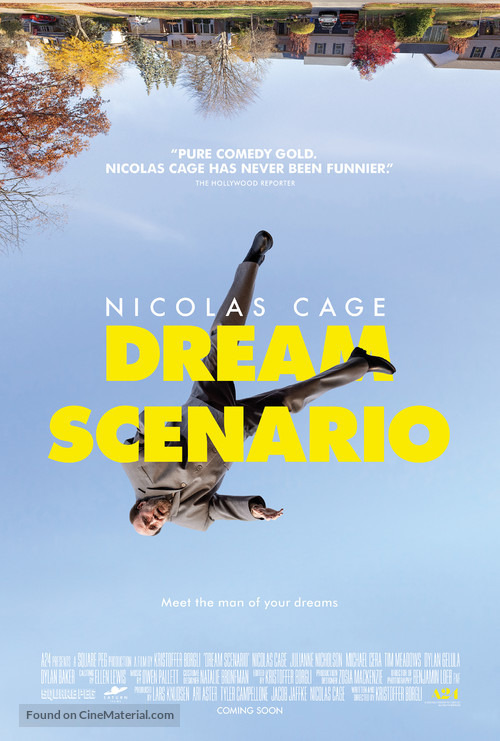
This film features possibly the best fart joke in the history of the cinema. They should advertise that on the poster!
Plot: Hapless family man Paul Matthews finds his life turned upside down when millions of strangers suddenly start seeing him in their dreams. When his nighttime appearances take a nightmarish turn, Paul is forced to navigate his newfound stardom.
This past decade Nicolas Cage has managed to enjoy a real comeback. Ever since he's paid back all those millions he owed to the IRS, he no longer needs to accept every acting role that's offered to him. He instead actually chooses some exciting and weird projects. Though they don't always pay off, they exhibit his care for the craft and consistent strive to deliver something different to his audience. Simply observing his last few years in the business, he's given us movies like Pig, Unbearable Weight of Massive Talent, Color Out of Space, Mandy, Into the Spider-Verse, Willy's Wonderland, and Mom & Dad. Heck, even Croods 2 was way better than expected - me and my fiancée laughed our heads off. Again, not all those films are masterpieces, but they certainly are different and provide a visceral viewing experience. So when I heard that Nicolas Cage was teaming up with A24, a studio that too recently stands out as a production company striving to give new filmmakers an exciting voice in the indie medium, it simply felt like a match made in heaven. Thus we have Dream Scenario.
Look, folks who know me know that I adore Nicolas Cage, so I do not want to come off as biased when I say this, but Nicolas Cage is great in this movie. Nope, it's not due to him having yet another weird haircut (what's with that recently by the way??). It's the fact that he manages to act as this very regular Joe, yet still makes him stand out. From his awkward demeanor, an honest naive outlook, and his voice - he was pitch-perfect, managing to be hilarious in his inept old-school perspective on things. It's Nicolas Cage at his best. Also, I have read that originally Adam Sandler was pitched for this role, and though I can see his farcical nature fitting in, it would have been a very different character to that delivered by Cage. Additionally, supporting turns from Julianne Nicholson, Tim Meadows, Dylan Gelula and Michael Cera were all welcome additions to the movie.
As for the film itself, it's also great. I love this idea of a random dude suddenly appearing in people's dreams for absolutely no reason. It's so rare to have a new original conception in a film in our day and age. Though this film could have so easily fallen into the trap of being an elongated one-joke, the creative team behind this seems to know what they are doing. Talk about getting everything out of a concept. The movie starts and you think, okay this is a lot of fun, but where are they going to go from here? Have no fear, they have plenty of tricks up their sleeves and the wild ride continues throughout. The film is hilarious. It contained some of the biggest theatre laughs I've heard in a long time. But it's more than that too. It actually gets quite touching and sad and has some really thought-provoking stuff going on. I do think it gets a tad lost in the cancel culture message, but only slightly.
The fact that this film started out as a project of Ari Aster is no surprise, as it has much in common with Beau is Afraid - notably the hapless and powerless central character and some surreal and blackly comic moments. In fact, what I really enjoyed was when the film leaned into that element of horror and the grotesque. Some of the nightmarish dream sequences really had that unsettling shock factor. I wish the movie was willing to go further into that, as even though I really like that the film went the more melodramatic route, in my mind I also wanted something even darker. That's not a gripe, but more so an observation of how a different vision for this film could have played out.
As for the aforementioned fart scene. Not spoiling anything, but this gag had the audience members in the screening howling with silent breathy cackling. It is one of the most well-calibrated comedic moments I've ever witnessed. The build-up to the timing and the actual punch line was simply sublime. Also, for a fart gag, it never felt crude, which is impressive in itself.
Overall Dream Scenario is a real treat. It has a very limited theatrical release here in the UK so had to travel to a different city to see it, but I'm so glad I did as one can never get enough of the man, the myth, the legend that is Nicolas Cage.
Overall score: 8/10

#dream scenario#movie reviews#film reviews#film#movie#comedy#melodrama#horror#drama#cinema#nicolas cage#a24#a24 films#2023#2023 in film#2023 films#2023 movies#kristoffer borgli#julianne nicholson#michael cera#tim meadows#noah centineo#dylan gelula#dream scenario review#ari aster#dream#cancel culture
2 notes
·
View notes
Text
Kenji Nakamura’s Next "Mononoke" Film Reveals Stunning First Trailer

Anime fans rejoice as the long-awaited Mononoke Trilogy – Chapter 2: Hinezumi has released its first trailer, offering a mesmerizing glimpse into Kenji Nakamura’s next eerie masterpiece. The sequel follows up on the Mononoke series' signature mix of psychological horror and surreal aesthetics, once again featuring the enigmatic Medicine Seller as he confronts supernatural entities in a richly stylized world. The trailer teases an intense and visually striking continuation of the first chapter, capturing the series' distinct storytelling and unique blend of Edo-period motifs with modern animation techniques. Kenji Nakamura, known for his unconventional narratives and visually innovative works like Mononoke (2007) and Gatchaman Crowds, continues to push artistic boundaries with this latest installment. Fans of the franchise have eagerly awaited Hinezumi since the first chapter reignited excitement for the Mononoke universe. What the Trailer Reveals The teaser introduces a foreboding atmosphere, with glimpses of the Medicine Seller navigating a fiery, nightmarish setting. Cryptic imagery, haunting character designs, and intense soundscapes set the tone for what appears to be another gripping supernatural mystery. The Mononoke series is known for its profound themes exploring human emotions, karma, and folklore, and the upcoming film seems poised to deliver another thought-provoking experience. Release Details and Expectations Though an exact release date has yet to be confirmed, Mononoke Trilogy – Chapter 2: Hinezumi is expected to premiere later this year. Fans are already speculating on the film’s plot and themes, drawing connections to previous entries and Japanese folklore. With its breathtaking animation, unsettling atmosphere, and thought-provoking storytelling, Hinezumi is shaping up to be a must-watch for anime enthusiasts and longtime followers of the Mononoke series.

Read the full article
0 notes
Text
Teaching Feeling: A Deep Dive into the Visual Novel

Teaching Feeling is a unique visual novel that sparks both curiosity and controversy. Created by developer FreakilyCharming (FreakÜyâ), the game dives into themes rarely explored in mainstream titles. With its psychological undertones and intense narrative, Teaching Feeling invites players to ponder choices, ethics, and the human need for connection.
What is Teaching Feeling?
At its core, Teaching Feeling is a simulation game with strong visual novel elements. Released in 2015, it garnered attention due to its unconventional premise. The story begins with the player character, a doctor, receiving a girl named Sylvie. Her past is marked by trauma and abuse, and your role is to guide her toward recovery. The choices you make determine whether Sylvie heals or falls deeper into despair.
Visual Design and Atmosphere
The artwork in Teaching Feeling stands out. The character designs are expressive, capturing Sylvie’s fragility and gradual transformation. The environments are simple yet effective, using muted colors to reflect the game’s somber mood. Subtle visual cues—Sylvie’s eyes, posture, and reactions—respond directly to your actions. These details make the experience intimate and engaging.
The interface is straightforward, focusing the player’s attention on interactions rather than complicated mechanics. This minimalist approach supports the game’s emotional weight.
Themes and Narrative Depth
Teaching Feeling delves into heavy themes. Trust, recovery, and morality sit at the center of the story. The game challenges you to consider how you treat someone who has suffered trauma. While controversial for some, the narrative pushes players to reflect on responsibility and empathy.
Sylvie’s character development depends on the player’s choices. Do you build a safe environment for her? Or exploit her vulnerability? The game doesn’t force you to take a moral high ground, which has led to mixed reactions. This freedom of choice is both the game’s strength and its most debated feature.
Gameplay Mechanics
The mechanics are simple but effective. You interact with Sylvie through dialogue and actions. These interactions impact her trust and mental state. Over time, Sylvie’s reactions change based on how you treat her. Small actions—like offering a gift or having a conversation—have significant consequences.
This design keeps players aware of their behavior. The lack of complex gameplay puts the focus squarely on emotional engagement. Every decision feels personal, making the experience immersive.
Controversies and Criticism
Teaching Feeling has faced its share of controversy. Some critics argue the game’s premise is problematic. They claim it blurs lines between helping and exploiting a vulnerable person. Others praise it for handling trauma with care and nuance.
The game’s freedom to choose darker paths unsettles some players. This discomfort is intentional, forcing players to confront their decisions. Whether this approach is ethical remains a hot topic.
Why Teaching Feeling Matters
Despite the controversies, Teaching Feeling holds significance in the visual novel genre. It experiments with moral ambiguity and emotional depth. The game shows that interactive fiction can explore themes as complex as any novel or film.
It also highlights the power of choice-driven storytelling. Unlike traditional narratives, your decisions shape the outcome, making the experience personal and reflective. This is why Teaching Feeling continues to draw attention years after its release.
Conclusion
Teaching Feeling is not a game for everyone. It requires emotional investment and a willingness to engage with difficult themes. Yet, for those who give it a chance, it offers a thought-provoking experience. The game’s strengths lie in its raw exploration of trust, healing, and choice.
1 note
·
View note
Text

Maps to the Stars stands out as one of the more difficult entries in David Cronenberg's filmography. Unlike other Cronenberg movies, which can sometimes be criticized for being dull (Fast Company, the original Crimes of the Future, Stereo) or pretentious (Cosmopolis), Maps to the Stars has a unique flaw: it's downright obnoxious. While billed as a dark comedy, the humor fails to land, leaving viewers with an unpleasant cast of horrible people. Imagine an unfunny version of Boogie Nights, and you’ll get a sense of this film’s tone.
The lack of redeemable qualities in the characters isn’t necessarily a dealbreaker—I’m a fan of Bad Lieutenant and It’s Always Sunny in Philadelphia, where unlikable characters are handled in a way that conveys insight into the human condition or dark humor. However, Maps to the Stars falls flat in this regard. The presentation of these characters lacks the depth or humor that might make their awfulness compelling or at least amusing, leaving them merely repellent.
Cronenberg's detached approach amplifies this problem. His signature distance from the material leaves the film feeling emotionally hollow, making it difficult to engage with any of the characters beyond feelings of annoyance and disgust. This clinical approach works great for making his horror films unsettling, but it's frustrating in a drama or comedy.
Without any discernible theme, message, or moral perspective, Maps to the Stars ends up feeling like a shallow critique of the toxicity of Hollywood culture—a point that, while I agree with it, feels obvious and unoriginal. For a director known for his unique explorations into human psychology, this film feels oddly commercial and uninspired, even featuring supernatural elements like what appear to be ghosts—an unusual choice for the self-described "hardcore atheist" that is David Cronenberg. While he’s occasionally worked on projects for the paycheck (M. Butterfly, Fast Company), this is the first time it genuinely feels that way.
Despite these issues, the performances are solid, elevating the material slightly. Yet without a more worthwhile script or vision to support them, the cast’s efforts go largely unrewarded. All in all, Maps to the Stars is an unfulfilling and unpleasant experience that feels like a misfire in Cronenberg’s otherwise thought-provoking career.
1 note
·
View note
Text








“You know what kind of plan never fails? No plan. No plan at all. You know why? Because life cannot be planned. Look around you.”
Parasite (2019)
Dir. Bong Joon-Ho
Comedy/Thriller
tiffsflickpick score: 4/5
Rotten Tomatoes: 99%
“Parasite” directed by Bong Joon-Ho is an excellent dark comedy riddled with suspense. It serves as a commentary on wealth and class which is constantly mirrored between the two main families. Every twist keeps you on the edge of your seat wanting more and more. The created characters have such depth and every character plays their role spectacularly. The ending is beautiful and yet heartbreaking in a way that will make you think about it after the screen has gone dark. This thought provoking and unsettling film is also beautifully shot. On looks alone, I could rate this to be one of the best films I’ve seen! Hopefully if you haven’t seen this film, you will soon because you are missing out!
#movies#film stills#films#movie#movie review#horror films#thriller#parasite#bong joon ho#idk how to tag this#thriller movies#dark comedy#aesthetic films
1 note
·
View note
Text
Civil War 2024: A Road Trip Through a Fractured America

Craving a suspenseful character study that explores the dangers of political division amidst a second American Civil War? Look no further than Alex Garland's "Civil War" (2024). A24 delivers a visually stunning dystopian thriller perfect for fans of thought-provoking films with a unique blend of political commentary and pulse-pounding actionThis dystopian thriller takes viewers on a harrowing journey across a fractured America, following a team of journalists embedded with the resistance during a terrifying second Civil War. Packed with stellar performances, "Civil War" 2024 will leave you thinking about the dangers of political division and the human cost of conflict. https://youtu.be/XWnr2Rinmfs Strap yourselves in, moviegoers, because Alex Garland's "Civil War" 2024 is a wild ride. Let's unpack what makes this dystopian thriller a must-watch. The Good First, the cast is phenomenal. Kirsten Dunst absolutely owns the screen as Lee Miller, a seasoned war photographer with nerves of steel (well, most of the time). Early in the film, Dunst delivers a raw and emotional performance as Lee captures the chaos of a conflict between police and a desperate crowd in the NYC area. The scene is eerily reminiscent of recent protests, and Lee's intense yet beautiful photographs showcase both the brutality and the resilience of the moment. This is just one example of Dunst's stellar performance, which perfectly captures the dedication and grit of a seasoned war photographer. Wagner Moura delivers a powerful performance alongside Dunst, and Cailee Spaeny, while occasionally frustrating, portrays a rookie journalist perfectly. Even the supporting cast, including Stephen McKinley Henderson, shines in their roles. The film masterfully utilizes silence to heighten tension during action sequences and showcase the devastating human cost of war. There are also some breathtakingly beautiful shots scattered throughout the movie, making it visually stunning. The Bad Now, let's buckle up for the bumps in this otherwise wild ride. The biggest letdown? The trailers are misleading. This isn't a war epic filled with soldier shootouts; it's a character-driven journey following journalists embedded with the resistance. We never delve into the conflict's cause, the political climate, or the global response, leaving a frustrating void. This is a major letdown considering the trailers heavily feature war scenes, leading audiences to expect a grand war epic. However, the film shines when it focuses on its core strength: the characters. Early in the film, Kirsten Dunst delivers a raw and emotional performance as Lee Miller, a seasoned war photographer with nerves of steel (well, most of the time). Dunst captures the chaos of a conflict between police and a desperate crowd in the NYC area. The scene is eerily reminiscent of recent protests, and Lee's intense yet beautiful photographs showcase both the brutality and the resilience of the moment. This is just one example of Dunst's stellar performance, which perfectly captures the dedication and grit of a seasoned war photographer. The soundtrack is another missed opportunity. Awkwardly placed rock music clashes with the film's serious tone, while jazz and hip hop feel equally out of place. Honestly, it felt like someone forgot to unmute their phone at times. These jarring musical choices remain a puzzle. Speaking of out-of-place, the movie portrays a West Virginia refugee camp that's more than a little unsettling. The imagery of mostly Black and brown people fleeing the war raises some uncomfortable questions about representation. While the film doesn't heavily focus on representation, the specific use of Black and brown characters in these scenes is concerning. Finally, Cailee Spaeny's character, Jessie, is the definition of annoying. Her constant bad decisions and damsel-in-distress moments will have you wishing for the fast-forward button. What's really bothering me is her complete arc and her impact on other characters. The Verdict "Civil War" 2024 is a visually stunning film with a phenomenal cast. While a misleading premise and a confusing soundtrack hold it back, the film delivers a powerful character study set against a war-torn backdrop. If you're a fan of A24's unique style and character-driven stories set in dystopian worlds, "Civil War" 2024 might be worth checking out. However, if you're expecting a traditional war epic, you might be disappointed.
0 notes
Text
Analog Horror Films as Social Commentary Tools
youtube
Analog horror films represent a distinct genre that combines vintage recording equipment and aesthetics with a strong emphasis on storytelling and social commentary. These films have gained popularity for their ability to immerse viewers in a world of nostalgia while simultaneously challenging conventional cinematic norms. Discourse analysis is the backbone of these films, enabling filmmakers to dissect and interpret societal issues using dialogue and visual imagery. When applied to film, it provides a unique lens through which to examine and interpret societal problems. Analog horror films take full advantage of this analytical approach by employing discourse analysis to reveal hidden layers of meaning within spoken and visual communication.
In analog horror, the power of visual storytelling transcends the traditional narrative structure. The vintage aesthetics and recording equipment, including VHS cameras and audio tapes, create a tangible link to the past, effectively transporting viewers to a different era. It's not just about what characters say but how they say it, how the visuals complement the dialogue, and how the overall aesthetics contribute to the social commentary. In another sense, analog horror films delve into cultural and societal issues that are both timely and timeless. These films are far more than a means of entertainment; they are platforms for dissecting and interpreting the complexities of society. Themes like isolation, technology, nostalgia, and the human condition are frequently explored within this genre. Thus, with its distinct vintage aesthetics and discourse analysis, it becomes a thought-provoking medium for addressing contemporary issues. It is a playground for filmmakers to explore the intricacies of human behavior, societal norms, and the consequences of various actions.
youtube
The Design of Analog Horror Films
Analog horror films are renowned for their nostalgic authenticity. They transport viewers to a bygone era, using vintage equipment such as VHS cameras and audio tapes to evoke a profound sense of nostalgia. The nostalgic power of analog horror films is a testament to the strength of their design. Viewers are transported back to a time when technology was simpler, yet the human experience was just as complex. Using outdated equipment becomes a time machine, invoking memories and emotions associated with the past.
It also has a unique ability to evoke nostalgia, which can be likened to opening a time capsule. The vintage aesthetics, be it the grainy visuals, the mechanical sounds of analog devices, or the imperfections in the recordings, create a sense of authenticity that is hard to replicate through modern digital filmmaking. Viewers find themselves transported to a different time; this emotional connection is a key component of their engagement with the narrative.
Analog horror films are celebrated for their ability to subvert traditional cinematic conventions. They do not adhere to the standard rules of storytelling but create an unsettling atmosphere that challenges viewers' preconceived notions. Indeed, it disrupts the established storytelling patterns, creating an atmosphere that leaves viewers with a sense of disquiet. By challenging conventional storytelling conventions, these films encourage audiences to actively question the narrative, explore its thematic depth, and uncover the social commentary beneath the surface. The element of surprise keeps viewers attentive and intrigued.
Viewers of analog horror films are encouraged to actively analyze the source material, whether it's a found footage narrative or a first-person perspective. It's a departure from passive viewing and encourages viewers to participate actively in storytelling. The engagement doesn't end when the film concludes. Analog horror films often serve as conversation starters, fostering meaningful discussions and debates about the narrative presented. This engagement extends beyond the screen, highlighting the power of analog horror to provoke thought and spark discussions.
The rawness and realism of analog horror films contribute to their appeal. These films embrace the imperfections of outdated technology, adding layers of authenticity to the narrative. Viewers connect with the raw, unfiltered quality of the storytelling, making the social commentary more relatable. Analog horror achieves this by eschewing modern filmmaking's slick, high-definition visuals, instead embracing the grainy, imperfect look of vintage recording. It doesn't shy away from the imperfections of outdated technology. It doesn't strive for modern cinema's pristine visuals and flawless audio. Instead, it embraces the occasional distortion, visual glitches, or audio artifacts. These imperfections add layers of authenticity to the narrative. This connection facilitates a more profound and relatable reception of the social commentary, making the issues more tangible and emotionally resonant to the audience.


However, analog horror films have a distinct appeal that may limit their reach to a niche audience. This niche appeal is characterized by an appreciation for vintage aesthetics and the willingness to embrace subversive storytelling. That’s why filmmakers must balance artistic expression and ensure their social commentary is accessible to a broader audience. While analog horror films may have a limited appeal, they can still be designed to make the social commentary accessible to viewers beyond the niche audience. This requires careful consideration of how the narrative is presented and the depth of the discourse analysis integrated. Also, people behind this medium should address the risk of misinterpretation by implementing strategies and techniques that facilitate a better understanding of the social commentary. This involves using visual and auditory cues that guide viewers toward the intended interpretation to ensure the balance between embracing the aesthetics of analog horror and ensuring the core message is not lost.
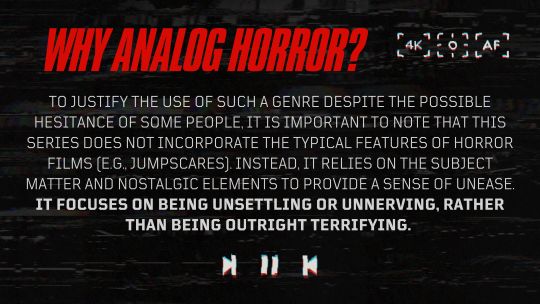
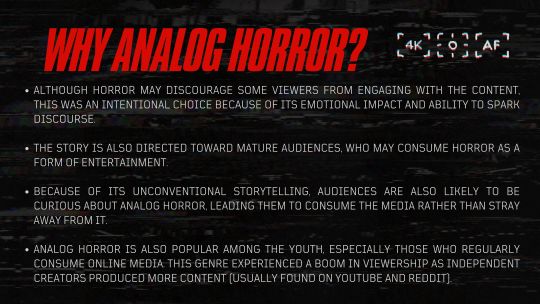
0 notes
Text
The Hidden Depths of Jordan Peele’s Us
In the enigmatic world of Jordan Peele’s film Us, our perceptions of horror are turned on their head. Known for his groundbreaking exploration of oppression and white supremacy in Get Out, Peele’s Us emerges as a cinematic surprise, challenging viewers with its layers of subtextual social commentary. It’s a film that doesn’t just entertain but forces us to confront the unsettling aspects of society and human nature that often linger in the shadows.
One of Peele’s defining attributes is his commitment to centering Black characters in his narratives. Us is no exception, with the Wilson family at the forefront, portrayed with astounding depth by Lupita Nyong’o and Winston Duke. They grapple with nightmarish circumstances, offering a refreshing departure from the typical horror movie tropes.
The crux of Us revolves around the existence of the “tethered,” a disturbing outcome of a failed government experiment. These doppelg��ngers have been dwelling in subterranean tunnels, shadowing the lives of their surface-dwelling counterparts in a horrific reflection. Just as these doppelgängers remain hidden from view, so do the societal traumas, struggles, and inequalities persist. Us demands the audience to confront the concealed horrors that fester in our society, often evaded or denied.
It was supposed to be a perfect day at the beach for Adelaide and Gabe Wilson, a chance to unwind and enjoy some quality time with their kids. But little did they know that their picturesque day would take a chilling twist when their son, Jason, wanders off, turning their outing into a nightmare. And as if that wasn’t enough, let’s not even get started on the character of Zora, Jason’s sister. Zora’s doppelgänger is absolutely petrifying with her eerie presence and mysterious aura, bringing a bone-chilling tension to the film. Yet, the horror doesn’t stop there. Imagine being confronted in the middle of the night by your evil twin, a concept that’s not only terrifying but plays with the very essence of our deepest fears.
Peele’s subtle approach to violence against Black characters in Us stands in stark contrast to the genre’s traditional shock tactics. Peele’s calculated restraint in depicting violence against Black characters adds an extra layer of intensity to the film, making it all the more thought-provoking. At first glance, Us offers an exhilarating tale that keeps audiences on the edge of their seats. The film excels in taking ordinary situations and transforming them into a horrifying spectacle, blending the mundane with the surreal.
Some critics might argue that the film lacks explanation in its story deliverance, but I implore you to delve deeper. Us is not just a horror film, it’s a complex and mind-bending experience that pushes the boundaries of what the genre can achieve. It challenges our perceptions, leaving us questioning the duality of human nature and the dark, uncharted territories that lie within.
So, if you’re a fan of horror that doesn’t just rely on jump scares but instead weaves a disturbing narrative that leaves you unsettled, Us is a must-watch.
0 notes
Text
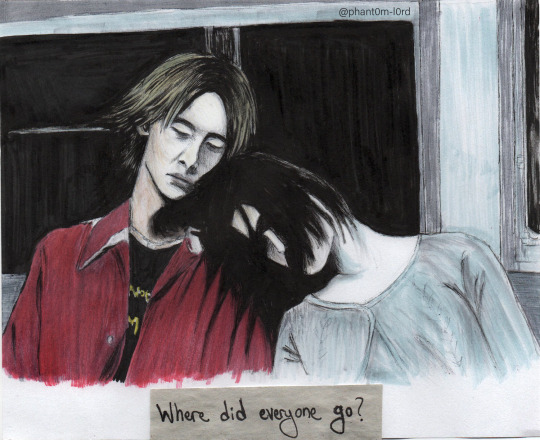
Pulse / 回路 (Kairo) (2001).
(fineliner, India ink brush pen, black coloured pencil, alcohol markers)
#watched this film the other night and I loved it so much I had to draw one of my favourite scenes#what an unsettling yet thought-provoking film#loved how it tackled the fear of death and loneliness#Pulse#Pulse 2001#回路#Kairo#japanese cinema#fan art#fanart#traditional art#lisa's art
73 notes
·
View notes
Photo










Chris Hemsworth with an absolutely STELLAR performance as Steve Abnesti in Spiderhead. Now streaming on Netflix.
It is so refreshing to see him stepping out from being pigeon holed by Marvel and Marvel fans. He is continuously underestimated and underappreciated, and the sky is truly the limit. It’s wonderful to see him be able to flex his acting talents, and take on the role of producer/executive producer on a number of films. He’s way more than just a pretty face and killer body, folks. And I hope that more people start to realize and appreciate that. He deserves far better than he’s been given in regards to his skill level.
Spiderhead is off beat, quirky, dark, and thought provoking, and (along with a fantastic supporting cast) Chris puts in the performance of his life. Embodying the sociopathic, narcissistic ‘mad scientist’, the charming and enigmatic Abnesti is truly one of the best villains I’ve seen in modern cinema. His back story, charisma and genius level intelligence often swaying you over onto his side. He manages to make you sympathize with him, and understand his motivations WHILE questioning your own thoughts and beliefs on humanity, the corrosion of, and the basics of human behaviour.
Joseph Kosinski with the win as director. It’s far and refreshing cry from Top Gun: Maverick, which in itself is fantastic in the otherwise dull and boring action film genre. With Spiderhead, Kosinski proves himself to be a talented man behind the camera here. Unlike the absolute shit fest of Interceptor (one of the WORST films I’ve EVER tormented myself with), Kosinski manages to create a masterpiece with very little in regards to set; the vast majority of the film recorded on a sound stage, yet giving a rich and vast vibe. Spiderhead Research Facility and Penitentiary is a world of its own; feeling vast, yet suffocating at the same time. And unlike Interceptor, Kosinski is/was blessed with an extremely talented cast; turning what could have been a bland experiencing into an absolutely beautiful and haunting character driven piece.
People are asking ‘where’s the action?’ and that’s rather disheartening. Have we really become THAT as a society? We seek out films that we don’t have to use our brains during? Action films are a dime a dozen. Aside from the likes of Extraction and Top Gun: Maverick, most are pure and utter shit and just copy off one another. They’ve become marketable because of their simplicity. Those who enjoy an intelligent and thought provoking style deserve Spiderhead. Yes, it WILL make you think. And that’s not something to be afraid of it. It’s something to EMBRACE!!
Spiderhead is intelligent and deep and it will make you unsettled. It will make question whether you truly do know right from wrong. And consider how far you’d be willing to go to make the world a better place.
Five out of five stars.
36 notes
·
View notes
Text
Lana Del Rey Unreleased Ranked (2)
This is a re-ranking of Lana's unreleased songs, after making a first a few years ago. This is all my opinion, which I don't mind anyone disagreeing with but don't come for me for it - honestly, I like every song, despite any criticism, and this ranking is very vague. It's based on objective and subjective opinion.
This is the second of five posts, going past my least favourites.
Money Hunny
Lana details the downside of money, detailing the ways it ruins lives and causes more problems that good for some. However, it’s simplicity isn’t what makes Money Hunny fall short – it doesn’t resonate at all compared to Lana’s countless songs where she is either rich and famous or she is desperate for money (or men with money). As thought-provoking as Money Hunny is, it feels too twee and out of place in her money-adoring music to really hit hard. If Lana has spoken on the topic of how money can literally damage lives more, it would perhaps gel better with me, but with songs like Money Power Glory, National Anthem and Off To The Races (among many, many others), it doesn’t hit the mark as a Lana Del Rey (alternate names included) song.
Strangelove
Strangelove is hypnotising, from Lana’s mesmerising voice that gives her the impression of a Las Vegas desert temptress, seducing strangers and wishing for the simple pleasures of Christmas lights and mint juleps. It hits best for the first opening chorus.
Stoplight Delite
Opening with a tuneful mechanical whir, Lana’s song wouldn’t be amiss in a teen romance film. I’m not convinced by the mishmash of music – the more classical band instruments with unrelenting whirring begins to overwhelm the song. Lana’s at her sweetest in this however.
Daddy Issues
The music is a bit too harsh but it’s a nice enough song, referencing Baby Blue Love among others. It isn’t Lana’s best by far, messy with lyrics that go all over the place, but (yet again), it would be more promising if it was completely remade and produced properly. The demo, I Was In A Bad Way, is a lot more maudlin and less enthusiastic, so it does fall behind Daddy Issues.
Catch and Release
It’s another song that’s kind of creepy, with an eerie vibe thanks to the relentless, whining music and Lana’s razor-edged warnings in her lyrics. Lana is practically a megalomaniac in this song, completely selfish and unafraid to ask for – and get – what she wants. Yet it’s quite a hypnotising track that, with further production, could be more cohesive and dramatic.
Marilyn
One of her old live performances, Marilyn is too simple in its lyrics but is a strangely erotic tribute to Lana’s icon. Lana owns the stage in this performance, a more carnal honouring than some of her other outputs.
Noir
Lana really goes for it in this furious song of crushed self-esteem and badly treated lover. Lana lets her vocals rip and tear as she growls about her “papi”, her being merely his dolly to do as he pleases. It's not her most perfect song but she doesn’t hold back from letting her hurt and frustration spill over.
Bellevue
Lana utilises haunting harmonising in Bellevue and though she seems hung up on her lover not wanting her around (she repeats it, as if she can’t let go, throughout the song) she still convinces herself she could go back to the old days of drinking and not being hurt. It helps – her chanting – to bring out the emotion of the lyrics, and maintain that broken feeling she is so good at conveying whilst saying how happy she is.
Put Your Lips Together
Taking on the character of a femme fatale who can hold her own, Lana seduces the listener on top of a chilled instrumental. Her lyrics are little bit dirtier as much as her vocals aren’t their best in the choruses (of course, it being a rough demo might have something to do with that). It’s definitely a song that, if completed, could rank alongside Beautiful Player and Ooh Baby in her seduction library.
Starry Eyed
Starry Eyed is a romantic enough song, with a gentle plinking intro that leads to a rumbling, Born To Die-esque track – complete with Lana’s pretty vocals. However, it does tend to drag, a slow song that I find majorly skippable. The dragged-out choruses get tiring after a while of listening so I don’t frequently listen to this song.
Breaking My Heart
Lana is fully materialistic in this song, referencing multiple designer companies as well as her desire to be loved and party. It’s not too imaginative in its lyrics, instead pure pop with a mixture of lyrics that never quite come through with a particular meaning, but it’s a good enough bop.
Butterflies Part 1
A little love song about a tumultuous teen romance, Lana plays off the lovestruck teen ultimately in love with a guy not good for her perfectly. It’s heady and full of the rushes of love, emotive enough to get the feeling of a girl going mad from her relationship.
Ben
Lana, using the rain to her advantages, moodily comforts her executive love in the full femme fatale façade, quietly passionate. Lana, as much as she loves him, is still her own woman, insisting she will smoke if she wants and playing with her voice to showcase such control.
All Smiles
Lana puts on a happy smile as she mopes over Jimmy in this small-town, fifties-painted tale of a girl who wants a man she can’t have. She mostly hits the mark in this acoustic track and has the right foundations for a decent country ballad.
My Best Days
My Best Days is a short song of cleverly utilised trap beats, autotune and slowly layering instrumental in which Lana isn’t happy without her lover. The organ outro is gorgeous, and it’s a track that can perk you up or calm you down.
Get Drunk
Restless pace, whispered mocking and an overall darkly seductive tone – it’s unembellished and, in some ways, could play as Lana dealing with her past alcoholism (demanding whomever the song is directed to should get drunk). It’s a vibe Lana should explore more over a decade since Get Drunk and the like were made.
Let My Hair Down
A simple and spooky track, Lana has an acoustic jam session consisting of unsettled guitar, bongos and her voice. It’s rather repetitive but it’s something different that works well. It shows Lana doesn’t need too many fusses and frills on her tracks to make something captivating, much like her Sirens album.
Every Man Gets His Wish
The intro of upbeat whistling climbs into a lowkey track that goes from sensual stuttering and a sad chorus that still sounds like Lana has a smile on her face. The mood shifts along with the tune but it is altogether cohesive.
Dance For Money
As stripped as the pole dancer Lana plays, Lana gently teases and cajoles in her ode to older men, lemonade and motorcycles with little else.
Back To Tha Basics
Much like the title, this track is a little bit basic but it’s still zesty with a wonderful instrumental and some pop-inspired vocals.
Butterflies Part 2
Production isn’t perfect on this track but Lana has such promise in this song in which she compares to lured in girls to butterflies pinned to a wall, all at once melancholy, knowing and cheeky. It’s unfortunate that the lyrics are so hidden beneath the dominating instrumental, but with tweaking this stormer could be even better.
Children of the Bad Revolution
The kind of song that would be found on one of her albums, Children of the Bad Revolution is a pacy dedication to Lana’s life as a delinquent a la the 1950s starlets. It’s good but it’s not anything too impressive, instead a chilled track that is simply about being free.
Beautiful Player
Lana mopes in the track about a somewhat disliked girl (perhaps they’re all jealous of her) who is in love with one of her players, giving the feel of a villain club performer smiling with red lipstick on and black mascara staining her cheeks.
Lift Your Eyes
Lana takes control in this song, instructing her lover to lift his eyes, rise above his demons and join her in self-respect. It’s a fine alternative to her gushing and moping characters, and with machine-like music running under the song, Lana sounds stronger than ever.
Valley of the Dolls
In this compact track Lana is once again frustrated by her lover. It’s pained but pretty with her vocals once again taking the forefront.
C U L8r Alligator
Just an acapella demo, C U L8r Alligator is simply Lana’s voice with her beating a rhythm in time. However, I really do like this song. I think it would sound even better polished and complete, but for a rough demo it’s promising. The Kristijan Majic remix is the version I most listen to, which makes it sound even more eerie (and if anyone remembers the D1ETPUSSY video that went with it, you’ll get why this song doubly haunts me). It’s not Lana’s finest but it’s a song I would have loved to see developed.
In The Sun
In The Sun is so hot it burns, more heatwave than refreshing sunshine, as she scorns her ex-lover. It’s not the finest instrumental but Lana sticks her fingers up with incredulous shock that someone could betray her so. She keeps the vibe great paired with blue skies and swimming pools with the upbeat music.
Hot Hot Hot
Big Bad Wolf, a slightly different demo track, is what I favour – stripped back, sexily uneasy, the lyrics letting the vivid imagery of red skirts, red cars and devilish men shine. Yet Hot Hot Hot is a decent, if not cheesier, song too, the chanting great for singing along.
Trees
Lana and The Rich Whores strike out with this kickass band-driven track that showcases Lana’s feistier vocals strongly. The lyrics are sparse but the overall feel of Lana going nineties-rock-chick keeps me wanting more of her in this style.
Push Me Down
Rather than being like the controversial Ultraviolence, Lana keeps the ‘violence’ fun in this pacy song, demanding her bad boy treats her badly in the best way possible. With a mildly rock edge, it’s still distinctively party-Lana, reminding of a pop-ier True Love On The Side.
She’s Not Me
It isn’t particularly imaginative pop but Lana lets the guitars do the talking as she whispers her warnings to her ex-lover. Lana owns this track, and though it feels a bit amateur in comparison to her discography and some of her stronger unreleased music, it shows she would have been great even if she went for the noughties chart pop scene. Fun and punchy, it’s a song to play on repeat.
I Don’t Wanna Go
The tentative and tight intro gives me the vibe that Lana wants to avoid going home rather than simply wanting to hang out with her lover, and her pain-tinted vocals in the chorus only add to the theory. She compliments her fascinating guy throughout the verses, a little more restrained but ultimately tense in delivery, before confessing how much she wants to stay out.
St Tropez
This is a great track for dancing and a celebration of being a party girl with plenty of attention. Best played when you want to imagine yourself as the main character.
Summer of Sam
Lana has yet another song of being a cutesy bad girl, comparable to the likes of Dangerous Girl and Playground, but it’s still fairly generic, standard pop fare. Summer of Sam is still quite fun however, drenched in pop and even with a hint of rap-talking keeping the song lively.
I Talk To Jesus
Lana returns to her religious roots in a less blasphemous way (Body Electric, for example) and instead sings a sad ditty about wishing she could have her old life. Solemnly it remembers her past (as seen in her older music) where she had the trailer parks, Christmas lights and her equally holy boyfriend.
Axl Rose Husband
The imagery is rich and gorgeous, not to mention the reference to one of Lana’s idols, but Axl Rose Husband doesn’t always do it for me – despite her strained, desperate vocals that perfectly exemplify her emotion.
Ooh Baby
Sampling Sexual Healing, Lana ramps up the sex appeal as she lets the listener know how much they want her, all while keeping it a little but more upbeat than the original song.
Other Woman
Lana’s tired of being the other woman in this track, and I like the way the lyrics flesh out the story a bit more rather. However, the chorus does get a bit tiresome sometimes.
Girl That Got Away
Lana shows you exactly what you’re missing as she mopes for her ex-lover with a smile on her face, taking the reins and knowing she has something he misses in a bubble-gum pop song about being the it girl you’ll regret letting go of.
15 notes
·
View notes
Text
The best and worst films of 2021
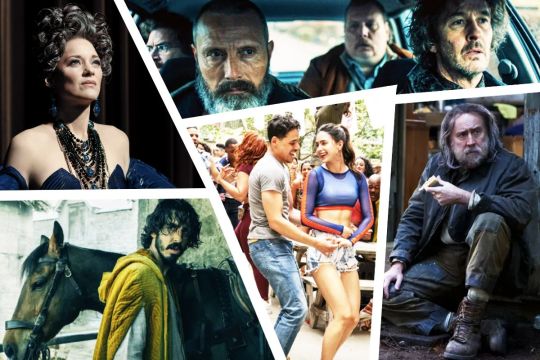
Unlike the previous year, 2021 was abundant with many great films in every genre, from horror and romantic comedy through to documentary and arthouse drama. Audiences were spoiled with a wide and impressive array of films, a reward well deserved having survived the first year of the pandemic
The year produced a number of sure bets from both well known directors and arthouse favourites, but it also treated cinemagoers to some truly unexpected treats from the cinematic mainstream.
Having had the opportunity to watch 106 films, those that made this year’s ‘best list’ have been selected on the basis of the lasting impression they have left on this viewer after the lights have come up and the curtain’s been drawn.
By way of small print, a film qualifies so long as it was first released into cinemas or onto streaming services in Australia between January through to December.
So, what succeeded and what failed?
Ladies and gentlemen, may we please offer for your consideration…
HONOURABLE MENTIONS
* D: Documentary N: Netflix A: Apple TV+
THE DISSIDENT (D) - TITANE - NO TIME TO DIE - A QUIET PLACE II - MALIGNANT - CODA (A) - NIGHT IN PARADISE (N) - THE DRY - THE TRIP (N) - NEWS OF THE WORLD (N) - LAMB - NITRAM - SYNCHRONIC - SOUND OF METAL - THE FATHER - ANOTHER ROUND - THE FRENCH DISPATCH - LICORICE PIZZA - DUNE

10. THE KID DETECTIVE
“Are you a detective, or just some idiot who believes everything he is told?”
A comedic mystery about what happens to a prodigy who’s burdened by high expectations, ‘The Kid Detective’ was a darkly clever satire of the hardboiled detective genre. Writer-director Evan Morgan’s impressive debut feature was also anchored by a terrific performance from former ‘OC’ star Adam Brody as a gumshoe in desperate need of redemption, sobriety and solving an actual mystery.

9. ST MAUD
“Never waste your pain.”
A deeply unsettling, yet superb first feature film from writer-director Rose Glass, this psychological horror was far more than just cheap jump-scares and mindless gore. At the heart of ‘St Maud’ was the effects of loneliness on a person’s mental health and the lunacy of taking religion far too seriously. With two excellent central performances from Morfydd Clark and Jennifer Ehle, ‘St Maud’ was an intense and thought-provoking film, and left audiences with one of the most haunting final frames in recent memory!

8. THE EMPTY MAN
“What is an abyss, and if you stare into it, why?”
You’d think from the misleading trailer that ‘The Empty Man’ was another cheesy small town boogeyman flick on the order of ‘The Bye Bye Man’ or ‘Slenderman.’ However, writer-director David Prior’s feature debut proved to be one of the more weirdly ambitious and occasionally avant-garde horror films to be released, the perfect experience for those fans who were up for a little wild ambition.

7. RIDERS OF JUSTICE
“You’re not dead inside. But you’re chubby.”
This Danish action/comedy was one of last year’s gems, delivering laughs and intense brutal action in equal measure. With its brilliant plot, ‘Riders of Justice’ balanced genres in seamless fashion and featured a remarkable central performance from Mads Mikkelsen. It may have been violent and action-heavy, but its distinctive comedic streak and surprisingly open heart made ‘Riders of Justice’ both hilarious and endearing.

6. THE SPARKS BROTHERS (DOCUMENTARY)
“Are you a real band?”
Directed by Edgar Wright, this affectionate and enlightening music documentary about the innovative rock group Sparks, formed by brothers Ron and Russell Mael, was an amazing love letter to ‘the best band you’ve never heard of.’ Lifting the lid on what Wright calls ‘your favourite band’s favourite band,’ ‘The Sparks Brothers’ was an often-hilarious celebration of the music and art from two oddball brothers who’ve never compromised and still haven’t stopped creating.
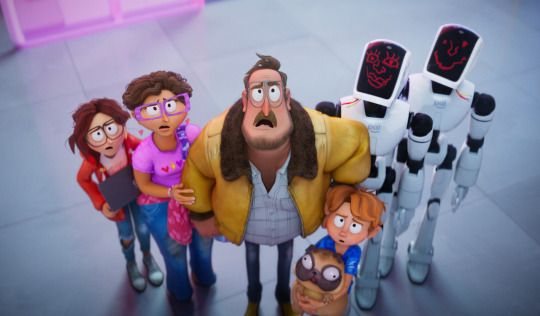
5. THE MITCHELLS VS THE MACHINES (NETFLIX)
“I’m here to bust criminals and lick my own butt. And I’m all out of criminals.”
There was so much to enjoy about writer-directors Michael Rianda and Jeff Rowe’s story about an unlikely family emerging as Earth’s saviours. With its absolutely gorgeous animation and smart, witty script, ‘The Mitchells Vs the Machines’ explored the connections between family and technology by utilising a glorious blend of comedy, emotion and riotous action. And a plentiful supply of laugh-out-loud moments!

4. SPIDER-MAN: NO WAY HOME
“You have power. And with great power, there must also come great responsibility.”
In a world inundated with superhero movies, it’s difficult for them to feel special anymore. However, this 27th entry in the MCU was an experience to savour, an action-packed and emotionally engaging conclusion to director Jon Watt’s ‘Spider-Man’ trilogy. Revealing a steady string of surprises throughout its 2.5 hour running time, ‘Spider-Man: No Way Home’ was a celebration of your friendly neighbourhood Avenger, solidifying the webslinger as Marvel’s most beloved superhero.
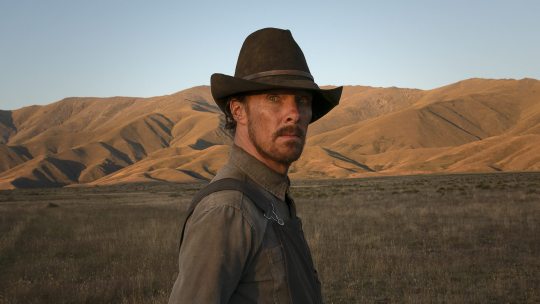
3. THE POWER OF THE DOG (NETFLIX)
“Deliver my soul from the sword. And my darling from the power of the dog.”
After taking a feature film directing break since 2009′s ‘Bright Star,’ Oscar-winning director Jane Campion returned with a literary tale that exposed the hard truths about loneliness, isolation and repression. Masterfully crafted and acted, with Benedict Cumberbatch giving one of the best performances of his career as a chilling and brutally savage cowboy, ‘The Power of the Dog’ was a haunting piece of filmmaking and a brilliant return to form for Campion.

2. PROMISING YOUNG WOMAN
“Can you guess what every woman’s worst nightmare is?”
This dark revenge comedy/thriller about a young woman who pretends to be a drunken vixen to test men’s ‘good intentions’ did for sexual assault what ‘Fatal Attraction’ did to cheating. Featuring a career-defining performance from Carey Mulligan and a wildly unpredictable finale, Emerald Fennell’s razor-sharp feature writing and directorial debut was an extremely necessary and satisfying watch.
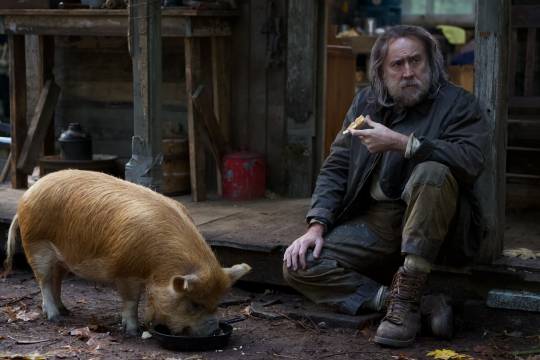
1. PIG
“We don’t get a lot of things we really care about.”
Let’s be honest.
When the trailer for ‘Pig’ was released, it appeared to be another ‘John Wick’ clone, with criminals stealing the beloved animal of a loner who happens to be a dangerous man who unleashes a bloody path of vengeance. However, filmmaker Michael Sarnoski’s directorial debut was less revenge thriller and more intimate character study about grief and loss.
Delivering one of the best performances of his career, Nicholas Cage was truly mesmerising as a man seeking the truth at all costs, and reminded audiences why he’s still one of the best in the business.
With its intimate cinematography and sorrowful score, ‘Pig’ was a poignant yet strangely beautiful film and quite easily the best of the year.
...AND NOW THE WORST!
DISHONOURABLE MENTIONS
* D: Documentary N: Netflix A: Apple TV+
THE MATRIX RESURRECTIONS - THE LAST DUEL - WRATH OF MAN - GEORGETOWN - THE CONJURING: THE DEVIL MADE ME DO IT - NO SUDDEN MOVE - HALLOWEEN KILLS - SHADOW IN THE CLOUD - REMINISCENCE - SPIRAL - ARMY OF THIEVES (N) - THE VELVET UNDERGROUND (D, A) - OLD - VENOM: LET THERE BE CARNAGE

10. BLACK WIDOW
“Such a poser.”
Clearly influenced by the ‘Jason Bourne’ franchise, Marvel’s long delayed solo outing for its first costumed heroine was a bloated dud, a joyless mix of uninspired action sequences and dysfunctional family drama. Directed by Cate Shortland (’Somersault’), ‘Black Widow’ failed in its attempt to tell a gritty superhero movie due to its underwhelming narrative and boring antagonist. In a word, meh.

9. ETERNALS
“They’re not worth saving!”
The biggest problem with ‘Eternals’ was that it failed to have one remarkable performance, scene or moment in its 2.5 hour running time that gave audiences the impression they were watching something marvellous, let alone decent. After the success of her Oscar-winning ‘Nomadland,’ director Chloe Zhao’s foray into the MCU was a colossal failure on numerous levels, a 156 minute snooze fest of routine stakes and plodding storytelling.
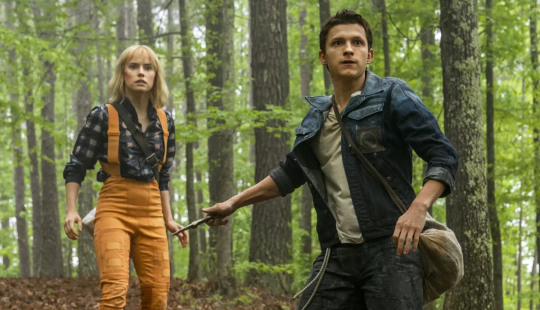
8. CHAOS WALKING
“The noise is a man's thoughts unfiltered, and without a filter a man is just chaos walking.”
Shot in 2017, director Doug Liman’s cinematic adaptation of Patrick Ness’s YA novel ‘The Knife of Never Letting Go’ never stood a chance given the film’s notorious production history. ‘Chaos Walking’ was deemed so profoundly broken and unreleasable that expensive reshoots couldn’t save it from failing at the box office, an outcome only made worse by the film being continually bounced around from one unattainable release date to the next.

7. MORTAL KOMBAT
“Kano wins. You fuckin’ beauty.”
It may have packed a visual punch with its die-hard fans, but this latest film adaptation of the classic video game was uninspired and far too concerned with creating a cinematic universe rather than telling a good story of action with interesting characters. Game over.
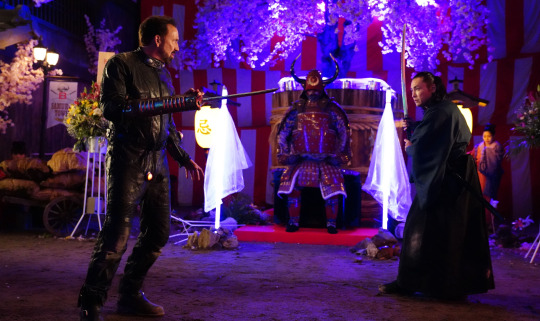
6. PRISONERS OF THE GHOSTLAND
“I’m not vermin!’
Nicolas Cage’s movie career in recent years has seen him accept any film role which is offered to him, with mixed results. Sometimes we get a ‘Mandy’ or a ‘Pig,’ while other times we get a ‘Prisoners of the Ghostland.’ With its mix of Eastern and Western cultures and truly striking visuals, director Sion Sono’s film may have been weird but was far from exciting or entertaining - even when there were two bombs attached to Cage’s testicles!
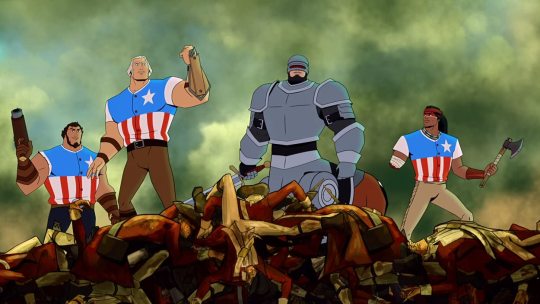
5. AMERICA: THE MOTION PICTURE (NETFLIX)
‘Ding dong, it’s America motherfucker!’
‘America: The Motion Picture’ was a loud and exceedingly stupid animated comedy that stretched its one-joke of ‘what if the Founding Fathers were dude-bros’ into a numbing 98 minutes. Even with talent such as Channing Tatum, Simon Pegg and Olivia Munn on vocals, nothing could hide the fact that director Matt Thompson’s (’Archer’) film debut was a laborious slog through an onslaught of puerile jokes (if you’d call them that).

4. INFINITE
“I must’ve really screwed up in my last incarnation.’
Stuck with an incomprehensible, half-baked idea that was executed with stale writing, mechanical acting and endless chase scenes and explosions, ‘Infinite’ was an absolute total failure. Directed by Antoine Fuqua (’Training Day’), this sci-fi action movie was a scattershot of ideas from pretty much every big action blockbuster from the past 20+ years and featured Mark Wahlberg as an unlikeable and extremely bland protagonist.
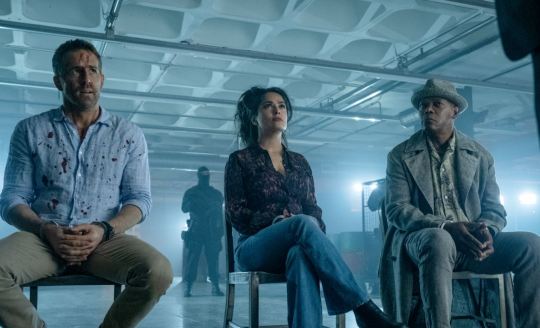
3. THE HITMAN’S WIFE’S BODYGUARD
“Oh, we are definitely gonna screw this up.’
This hapless retread of a forgettable movie from four years ago was nothing more than a tedious mix of comedy and action. Director Patrick Hughes’s sequel was an incoherent mess, with over-edited action scenes and an incredibly stupid script that made absolutely no sense. As for its comedy, the film’s jokes were virtually non-existent, relying on nothing more than an endless torrent of profanity and the making fun of accents. A total misfire.

2. MONSTER HUNTER
“This shit is officially above my pay grade.’
As video gamed-based movies go, this forgettable compilation of CGI was an incomprehensible mess that recycled what audiences had already seen in countless sci-fi actioners prior. Continuing his love affair with the cinematic adaptation of video games, director Paul WS Anderson (’Resident Evil’) made a film that put logic and characterisation to one side in the wake of pure CGI spectacle. Be thankful that it was only 93 minutes long.

1. THUNDER FORCE (NETFLIX)
“So, your parents were both lady part doctors?’
Having been responsible for such atrocities as ‘Tammy,’ ‘The Boss,’ ‘Life of the Party’ and ‘Super Intelligence,’ this fifth team-up between Melissa McCarthy and her husband, filmmaker Ben Falcone, posed a very serious question - what can we do as moviegoers to prevent them from ever making such garbage again?
As a superhero satire, ‘Thunder Force’ was a shapeless, underdeveloped mess of limp, repetitive jokes, with the action and suspense elements as underwhelming as the comedy. More blunder than thunder, any movie where Jason Bateman can’t pull more than one laugh from being a ‘crab man,’ clearly didn’t deserve your attention.
5 notes
·
View notes